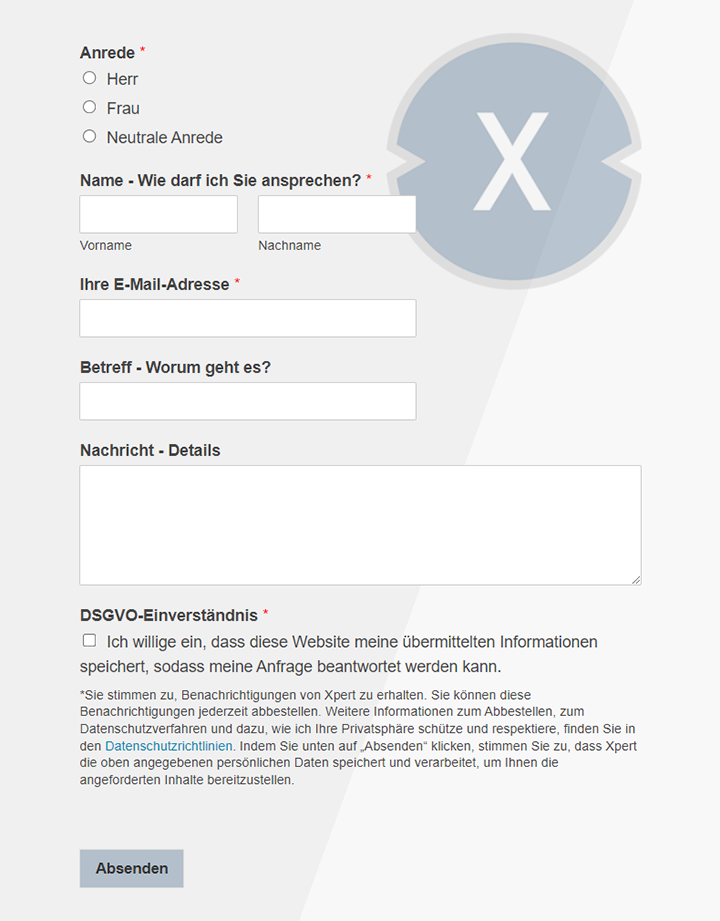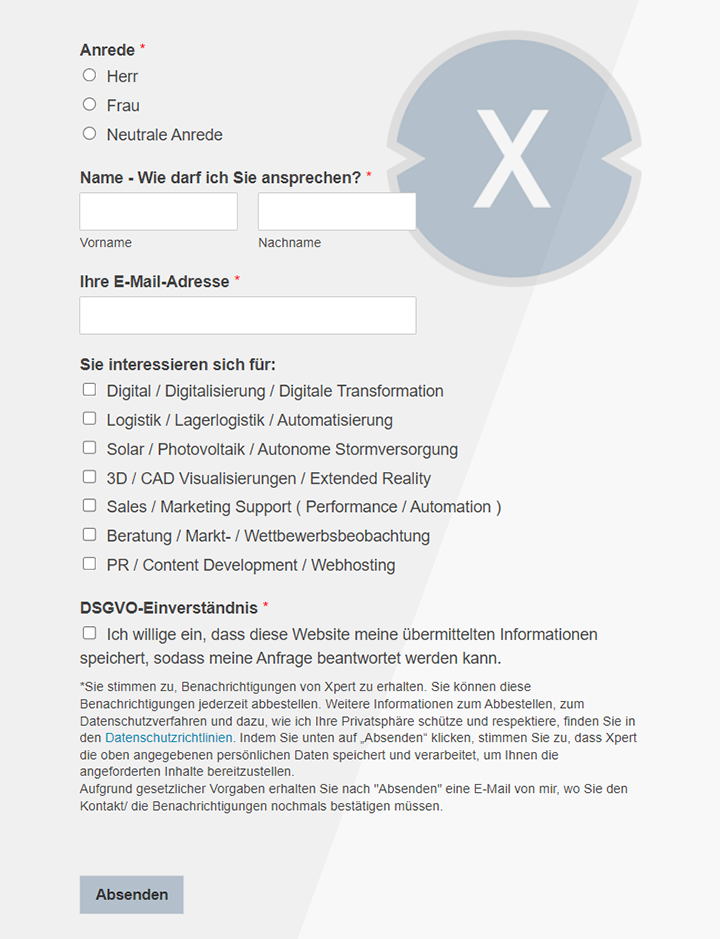The bureaucratic maze and its architects: a comparative analysis of the administration and the role of the advisory industry
Xpert pre-release
Language selection 📢
Published on: July 20, 2025 / update from: July 20, 2025 – Author: Konrad Wolfenstein

The bureaucratic maze and its architects: a comparative analysis of the administration and the role of the consulting industry – Image: Xpert.digital
The bureaucratic maze and its architects: a comparative analysis of public administration in Europe, the USA and Japan as well as the role of the consulting industry
The anatomy of bureaucracy: a story of three systems
This article explains the fundamental problem. It defines and deconstructs the nature of bureaucracy in Europe, especially in the EU and Germany, before using the systems of the USA and Japan as critical counterpoints in order to emphasize the unique features and challenges of the European model.
Suitable for:
- The central contradiction: Deburocratization, advise on the profiteers of bureaucracy – the error in the system of bureaucracy reduction
The European Labyrinth: Deconstruction of Bureaucracy in the EU and its Member States
This section shows that European bureaucracy is not just a accumulation of rules, but a systemic problem that has arisen from a unique combination of multi-level governance, a specific administrative culture and a significant digital deficit.
The necessary evil and the negative perception
The analysis begins with the recognition of the dual nature of bureaucracy: on the one hand, it is a necessary organizational apparatus for a democratically legitimized state that is active to secure the common good, on the other hand it is often negatively perceived as a “monster”. This creates the central tension of the analysis. The Weibersche ideal of a rationally based, regular -based administration, which ensures equal treatment for everyone, is compared to the experience of excessive complexity and inefficiency. Bureaucracy, often used synonymously with the term administration, is not negative per se, but the necessary organization of a state apparatus. However, criticism of the European Union's bureaucracy is omnipresent, both in the media and in European research. Supposed undesirable developments and excesses of European integration are generally attributed to the EU's bureaucracy. This negative connotation is widespread despite the opposite efforts.
Structural drivers: the EU's multi-level governance
The central structural problem is the institutional framework of the EU itself. The EU is a complex network of decision -making and executing organs, including the European Commission, the European Parliament, the Council of the European Union as well as a large number of agencies and specialized institutions. The European Commission, as the most important executive body, uses its “right of initiative” to submit proposals for new laws. These laws are then checked and accepted by Parliament and the Council. The crucial point, however, is that the legislation at the federal and EU level is the decisive tool for action, but the implementation is among the states and municipalities.
This division of tasks leads to a phenomenon called the “cascade of the transfer of tasks”. Legislation from the EU level flows to the national and then the local governments. This process adds layers of interpretation, regulation and administrative procedures to every level, often without adequate consideration of practical feasibility (“enforcement”) at the local level. This separation between legislation and enforcement slows down modernization processes and creates incentives that lead to unnecessary bureaucracy. If, for example, municipalities have to carry out new EU legal provisions, such as food control, without being able to rely on the connexuality principle (who ordered, paid), they often only remain the way to pass on the costs of enforcement to private and economic operators.
The nature of the EU as a “bureaucratic power” is deeply rooted in its internal structures of the delegation and the intergovernmental decision -making. This structure predisposes it into regular, multilateral approaches. While this structure enables cohesion, it also favors complex regulatory solutions compared to other forms of power. The EU is characterized by a preference for multilateralism and rule -based policy approaches, which shapes its external politics, but also makes its internal processes complex.
Cultural and historical drivers: the German case study
The specific administrative culture in important member states such as Germany significantly increases the structural problems of the EU.
- Risk aversion and the pursuit of “court strength”: A dominant characteristic of the German administration is an attempt to make every action “court -proof”, that is, legally unassailable and in court. This preventive defense against potential legal challenges suffocates pragmatic and efficient solutions in favor of excessively detailed, rigid and documented processes. This cultural property significantly exacerbates the complexity that emanates from the EU. Instead of finding practical solutions, the administration often anticipates possible judgments and acts in a way that is supposed to invalidate any conceivable objection in advance.
- Distrust and control: A culture of distrust between the administrative centers as well as between the state and the citizens and the company leads to excessive control and high verification loads. Instead of relying on principles such as samples, trivial boundaries or flat rates that could significantly reduce bureaucratic effort, a high control effort is carried out. This reflects a deep distrust that prevents efficiency -increasing measures.
- Silo thinking: deeply rooted department and agency silos (“silo thinking”) hinder the cross-office cooperation and project-based work, which are essential for the modernization and tightening of processes. This paradigm is opposed to networking and in particular cross -responsibility project work, which leads to significant loss of efficiency.
The combination of these cultural factors means that the problem of European bureaucracy is not solely located in Brussels. It is a systemic error that arises from the interaction between the supranational legislative structure of the EU and the existing, path -dependent administrative cultures of its most important member states such as Germany. EU guidelines are not self-managing; They are implemented in national law. If a complex, laid out guideline, which is designed for many states, meets a risk -free, legalistic and silos -thinking national bureaucracy, the result is an exponential increase in complexity and the perceived administrative effort. Therefore, it is too strong simplification to blame Brussels alone; The friction and reinforcement at the national level are responsible for the end result that citizens and companies experience, as well as, if not even more.
Suitable for:
- Typically German because we need a bureaucracy relief law? The current status of the economy and renewable energies such as PV
The digital deficit as a bureaucracy multiplier
Germany's considerable deficit in the digitization of the administration is a main cause of unnecessary bureaucracy. In the Digital Economy and Society Index (DESI) Report 2019, Germany only took 24th place out of 28 countries in e-government. This deficit is not primarily a technical problem, but reflects a lack of cultural change within the administration. The administration has failed to accept and carry out the changes associated with digitization.
The consequences are far -reaching: processes remain paper -based, communication is opaque, and citizens and companies are confronted with incomprehensible forms and unclear requirements. Irritating and unnecessary bureaucracy arises if responsibilities are unclear and requested documents are not clearly described. In contrast, the most economically efficient economies have a widespread use of electronic systems and online platforms for fulfilling regulatory requirements. The lack of digitization in Europe, especially in Germany, thus acts as a multiplier for existing bureaucratic hurdles.
Myth vs. Reality: Is the EU a “bureaucratic monster”?
The analysis must also deal with the common criticism, which is often symbolized by ordinances such as the curvature of cucumber and bananas. Some sources argue that this is a stubborn myth and the EU administration is not excessively large. They point out that the linguistic diversity of the EU, which requires extensive translations, is a necessary price for cultural diversity and contributes to complexity.
However, the perception of a “bureaucracy monster” is nourished by the very real structural and cultural problems that have been identified above. The complexity does not necessarily result from the number of bureaucrats – the EU Commission has fewer personnel than many major city administrations – but from the multi-layered, risk-loving and sub-igitalized nature of its legislative and administrative processes. The criticism that the EU is a “bureaucratic monster” that interferes absurd into the “structures of everyday life” may be exaggerated, but it is rooted in the tangible experience of inefficiency and excessive regulation. From a sociological point of view, it is not a matter of whether the EU has more or less bureaucratization tendencies, but rather about determining the specific type of bureaucracy at European level. This type is characterized by a pronounced tendency towards over -regulation and patronizing, which results from the unique institutional constitution of the EU.
The American and Japanese counter points: alternative administrative models
In this section, quantitative data and specific political examples from the USA and Japan are used to create a sharp contrast to the European model and to show different approaches to regulation and reform.
A quantitative starting point: the “Business activities easy” index of the World Bank
The analysis will be based on the World Bank “Business Report 2020”. Although this index was later discontinued due to data independence, it offers a standardized snapshot of the regulatory environment for companies, as was perceived at that time. The report measures regulations that directly affect companies and not more general conditions such as infrastructure or crime.
The following table summarizes the most important key figures for the compared economies and offers an objective, data -based basis for comparative analysis. It enables a granular diagnosis where the European model (represented by Germany and France) does below average compared to the USA and Japan.
Comparative “business activities made easy” metrics (business report 2020)
The analysis of the table shows that the United States (6th place) sections in the overall ranking 2020 significantly better than Germany (22), Japan (29) and France (32). A particularly revealing result for Germany is the exceptionally bad rank when “founding a company” (125th place), which requires 9 procedures and 8 days. This indicates high procedural hurdles for entrepreneurship and provides concrete evidence of the bureaucratic burden discussed in Section 1. France performs particularly poorly for building permits (60th place) and the tax load (55th place, with a total quota of 60.7%). Japan, in turn, has a high number of tax payments (13) and a very high amount of time for the tax return (330 hours), which indicates a complex tax bureaucracy.
The 2020 business report offers a comparative overview of various economic indicators in Germany, France, the USA and Japan. Overall, the United States occupies the top position with 6th place and a total number of 84.0, while Germany is in the middle with 22nd and 79.7 points.
When founding the company, there are clear differences: the USA ranks 5th with only 4 procedural days and minimal costs of 0.8% of the per capita income. Germany, on the other hand, ranked 125 with 8 process days and 6.5% founding costs.
In the area of building permits, Germany does 30th place better than France (60th place), but needs 126 days for the procedures. The United States is more efficient with 98 procedural days and rank 24.
The tax burdens are particularly interesting: France has the highest total tax and contribution rate at 60.7%, while the United States is significantly below with only 36.6%. Germany is 48.8% in the middle area. The number of tax payments and the time effort also vary greatly between the countries.
The US model: fragmentation and focus on cost reduction
The US system, although in its own way complex (e.g. through the coexistence of federal and state regulations), often offers a less procedural environment for business processes, which is reflected in its high ranking. Reforms in the United States often focus on direct reduction in costs. One example is the reduction in corporation tax rate, which directly improves the indicator “taxes”. This is in contrast to the European focus on procedural correctness and legal protection. The United States also makes it easier to start the company through the introduction of online submissions. This pragmatic approach, which is aimed at efficiency and cost reduction, explains to a large extent the lead in the “Business activities easy” ranking.
The Japanese model: state -run, internally driven digital transformation
Japan offers the most convincing strategic alternative to the European model. In recognition of its administrative inefficiencies, the Japanese government founded a new digital agency in 2021.
- Mission and structure: The agency's mission is to act as a “control tower” for the country's digital transformation by standardizing systems and overcoming data silos between government organizations. Your goal is to fundamentally improve public services and to abolish inefficient practices of the past. A specific goal is a “one-stop service” for citizens who make the repeated entry of the same information superfluous at various authorities.
- A new approach to expertise: It is crucial that the strategy of the digital agency is to actively recruit experts from the private sector and to integrate them into government roles instead of simply outsourcing projects to consulting companies. This represents a conscious step to transform the public service from a closed to an open system and to accumulate knowledge internally. It is a direct attempt to build up sovereign state capacities. The agency should act as a “lubricant” and reform engine to advance the government at national and local level.
This procedure represents a conscious strategic swivel away from the paradigm of “New Public Management” (NPM), which has dominated the reform of the public sector in the west for decades. It is an implicit criticism of the outsourcing model and an attempt to prevent the problem of “hollowing out” the state – a topic that is detailed in Part II. While the NPM model promotes the outsourcing of functions defined as non-core business, which, like critics argue, leads to a loss of internal skills and dependency, the Japanese model does the opposite: it is insourct talents and methods from the private sector (such as agile development) to build permanent, internal government capacity. This is not just a different tactic; It is a different government philosophy. It indicates recognition of the long -term risks at the highest level of the Japanese government, which are connected to the consultant -dependent model, which has established itself so much in Europe and the USA. This not only makes the Japanese reform into a technical project, but also a significant political and strategic course.
🎯🎯🎯 Benefit from Xpert.Digital's extensive, fivefold expertise in a comprehensive service package | R&D, XR, PR & SEM

AI & XR-3D-Rendering Machine: five times expertise from Xpert.digital in a comprehensive service package, R&D XR, Pr & SEM – Image: Xpert.digital
Xpert.Digital has in-depth knowledge of various industries. This allows us to develop tailor-made strategies that are tailored precisely to the requirements and challenges of your specific market segment. By continually analyzing market trends and following industry developments, we can act with foresight and offer innovative solutions. Through the combination of experience and knowledge, we generate added value and give our customers a decisive competitive advantage.
More about it here:
Invisible handlebar: how management consultants manipulate governments
The shadow government: the ubiquitous influence of external consultants
This part shifts the focus from the internal characteristics of bureaucracy to the role of a powerful external actor: the consulting industry. He will quantify the market, explain the reasons for the commitment of consultants and describe the mechanisms in detail, by which these companies have influence, often to the detriment of the capacities of the public sector.
Suitable for:
- The shadow bureaucracy: How external consultants German taxpayers and undermout the state's ability to act.
The advisory gold rush in the public sector
This section is intended to show the extent of the phenomenon and the underlying reasons why governments have become so dependent on external consultants.
Mapping of the market: size, growth and regional differences
The global market for consulting services in the public sector is a billion -dollar industry. However, the estimates of its size vary significantly depending on the source and methodology, which underlines the non -transparency of the sector itself. The figures range from around $ 76 billion in 2025 to over 518 billion in 2023. This discrepancy reflects different definitions of what is counted as “advice”, from strategic advice to IT implementation and outsourcing.
Market overview for consulting services in the public sector: a regional comparison

Market overview for consulting services in the public sector: A regional comparison – Image: Xpert.digital
The regional breakdown shows that North America is the dominant market. Germany and France are key markets in Europe. The proportion of the public sector in the sales of consulting companies in the USA (approx. 20%) and Great Britain (26%) is significantly higher than in Germany (10%), which indicates different degrees of dependency. The Japanese market is ripe, but in absolute numbers smaller. The growth is driven worldwide through the increasing introduction of digital technologies, increasing demand for outsourcing services and the growing need for specialized advice in areas such as cybersecurity and sustainable development.
The global market for consulting services in the public sector shows an impressive regional dynamic. North America dominates with an estimated market size of $ 29.08 billion in 2023, driven by advanced economies and a strong focus on strategic governance and digital transformation. The advisory services here focus mainly on financial, strategy and technology advice.
Europe follows with an overall advisory market of $ 18.87 billion in 2023, with the overall market in 2019 still being $ 45 billion. Regulatory requirements, economic transformation and digitization are characteristic of the European consulting landscape. The focus is on IT advice, strategy advice and administrative modernization.
In 2019, the Asian-Pacific area had an overall advisory market of $ 25 billion, driven by economic growth, infrastructure projects and digitization. Financial services, production, healthcare and the public sector play a central role here.
Japan presents itself as a mature market with a total volume of around $ 1.5 billion (2019), with a clear focus on increasing efficiency and digital transformation. It should be emphasized that IT advice is already 30 percent of the Japanese advisory market.
The reasons for the commitment: Why governments open the door
The massive use of advisors through governments has profound causes that are both practical and ideological in nature.
- The capacity gap: Governments are increasingly turning to consultants to fill gaps in knowledge and capacity, especially with new, complex challenges such as digitization, administrative modernization or climate policy. A proper use of external expertise can help the administration to find correct answers to new and complex questions in a rapidly changing environment. This need is often tightened by decades of cuts in the public sector that have eroded the internal expertise. The sociologist Silke van Dyk criticizes that the public service was "broken" in parts and that expertise has been lost.
- The rise of “New Public Management” (NPM): The analysis must identify NPM as the central ideological driver. This doctrine, who gained importance among politicians such as Margaret Thatcher and Ronald Reagan in the 1980s, frames the state as inherently inefficient and promotes the takeover of private sector, managerialist logic. Consultants are the primary carriers and advocates of this logic. They were historically introduced to the public administration to prevent market dominance and to react to the demand for specialized professional services. Contrary to the assumption that neoliberalism only cuts public expenses, he describes a more precise deflection of public expenses towards a stronger role of the market. Government spending in the Thatcher era rose real, while the expenses for consultants in the public sector in Great Britain increased.
- Legitimation and risk reduction: The commissioning of a renowned company such as McKinsey, Boston Consulting Group (BCG) or one of the “Big Four” (PWC, Deloitte, KPMG, EY) gives a appearance of authority and objectivity. It serves as a “scapegoat” and enables politicians and high civil servants to pass on responsibility; If a project fails, the consultant can be accused. Managers often use consultants to have decisions they wanted to make anyway, such as layoffs or cuts of F&-Budgets.
These factors create a self -reinforcing relationship. The ideology of the NPM justifies the outsourcing, which leads to the erosion of internal state capacities, which in turn makes the state more dependent on consultants in future tasks. The more a government outsourcies, the less she knows how to do things herself. This “infantilized” the government and makes it a permanent customer for the consulting industry. The problem (lack of capacity) and the solution (commissioning of consultants) are caught in a feedback loop that benefits the business model of the consultants.
Mechanisms of influence and the erosion of state capacities
This section passes from “why” to “how” and describes the specific paths in which consultants shape politics, as well as the negative consequences of excessive dependency.
From consultants to agenda replacements
Consultants are not neutral providers of advice; They are active political actors, the political agenda. You do this through different mechanisms:
- Control of information and framing of problems: They create influential reports and studies that frame political problems so that they favor their preferred (and profitable) solutions. Economic advisory companies use this to influence the legislation on behalf of customers and large technology groups, for example by flooding antitrust authorities with economic studies.
- Curatorial function: In reform processes, they act as moderators and gatekeepers who reinforce certain voices of interest groups (including their own) and marginalize others. They curate the input in reform packages, promote certain content and practice a form of self -extinguishing that undermines the accountability compulsory towards stakeholders.
- Exploitation of the revolving door: The movement of personnel between government and regulatory authorities and consulting companies creates powerful informal networks and potential conflicts of interest. Former officials of the European and national antitrust authorities are contracted by consulting companies, which gives them insider knowledge and access. The European Citizens' Commissioner has determined that there is a tendency to underestimate harmful effects if EU officials bring their knowledge and networks into related areas of the private sector.
The official criticism: the indictment of the German Federal Audit Office
The German Federal Audit Office provides an urgent, official criticism of the use of consultants by the federal government. His findings are not abstract, but are based on exams of over 90 real projects.
The main criticism of the Court of Auditors, summarized in ten key points, cover a wide range of failures:
- Inadequate problem and target definition: decisions are rarely based on a comprehensible problem analysis.
- A lack of need for necessity: The administration does not check critically enough whether it can provide the performance itself.
- Inadequate profitability testing: alternatives, including personal contribution, are not sufficiently valued.
- Individual description of performance: The desired service is not described clearly and comprehensively.
- Unclear design of the contract: Contracts are often indefinite, which makes control difficult.
- A lack of competition in the award: Orders are often given freehand instead of writing them down.
- Inadequate control and control: The administration does not control the projects properly.
- A lack of success control: A final, understandable success control often does not take place.
- A lack of transparency: There is no sufficiently cross -departmental exchange about consulting results.
- Inadequate documentation: The entire process is not documented in a comprehensible manner.
It is particularly serious that core tasks of the administration, such as the creation of the service description or the control of the contractor, are transferred to external. This official exam provides a robust, internal government confirmation of the more comprehensive external reviews.
The “Reflection” of the state
The most harmful long -term consequence of the excessive dependence on consultants is the erosion of the state's own abilities, a concept that is the focus of Mazzucato and Collington's work.
- Loss of institutional knowledge: If core tasks are outsourced, the organization does not learn through action. The knowledge is generated by the consultant, but often not effectively transferred to the customer or remains proprietary. This creates permanent dependency. The cumulative use of large consulting companies with extractive business models inhibits innovation, capacity development and learning.
- Inhibited innovation: The state loses the ability to solve and innovate its own problems. He will “get stuck in time” and unable to develop further. Former state -run innovations, for example in IT, are almost unthinkable today because this ability has been assigned to the private sector. Decades of privatization, lower public service salaries and the doctrine of state inefficiency have created a self -fulfilling prophecy: states no longer know how to perform key functions.
The opaque and informal nature of the advisory engagement creates a “shadow governance” structure that undermines the democratic accountability. Consulting services are often treated as simple “procurement” and thus fall through the stitches of the rules that apply to cooperation with other non -state actors or permanent staff. This lack of transparency means that important political -shaping activities take place outside of public control. Even the titles of advisory reports for the EU Commission are often not public. This “obscures political accountability” and enables decision -makers to “water down responsibility”. The result is a system in which non -elected, profit -oriented actors have a significant impact on public politics in a non -transparent way, which weakens the connection between elected officials, the policies they have issued and their responsibility towards the public. This represents a fundamental challenge for democratic government.
Our recommendation: 🌍 Limitless reach 🔗 Networked 🌐 Multilingual 💪 Strong sales: 💡 Authentic with strategy 🚀 Innovation meets 🧠 Intuition

From the bars to global: SMEs conquer the world market with a clever strategy – Image: Xpert.digital
At a time when a company's digital presence determines its success, the challenge is how to make this presence authentic, individual and far-reaching. Xpert.Digital offers an innovative solution that positions itself as an intersection between an industry hub, a blog and a brand ambassador. It combines the advantages of communication and sales channels in a single platform and enables publication in 18 different languages. The cooperation with partner portals and the possibility of publishing articles on Google News and a press distribution list with around 8,000 journalists and readers maximize the reach and visibility of the content. This represents an essential factor in external sales & marketing (SMarketing).
More about it here:
Consultant industry exposes: How experts take out the state
### Bureaucracy complexity decrypted: The strategy of the management consultants ### The big confusion: When consultants sabotage ### State on the drip: How external public administration ### Profit machine Advice: The systematic attack on state efficiency ### billions of millions in shade: The dark side of the management consultancy ###
The big fraud: investigation of the nuclear hypothesis
This part deals directly with the most provocative question of the user: deliberately undermine consultants to reform to your own advantage? He uses the “the big fraud” thesis as a lens to analyze the business models and incentives of the consulting industry.
The dilemma of the consultant: profit vs. common good
This section deconstructs the central argument that the business model of the consulting industry is fundamentally incompatible with the public interest.
The “the big fraud” thesis (Mazzucato & Collington)
The core argument of the book “The big scam” is that the industry carries out a “confidence” (Confidence Trick). It positions itself as an objective source of added value, but often delivers little, while it extracts “economic pensions” instead – income that far exceeds the value actually provided.
This is made possible by a dynamics of power in which consultants benefit from “hollowed out and risk -loving governments”. They sell security and expertise to customers who lack trust or ability to act independently. The authors argue that the dependence of our economies such as McKinsey, BCG, PWC, Deloitte, KPMG and EY innovations inhibits the entrepreneurial and political accountability and disabled our collective mission to stop climate change. “The big fraud” thrives on the evil of modern capitalism, from financialization and privatization to the climate crisis.
Convergence of the reviews: auditors and academics
The following table contrasts the criticisms of the German Federal Audit Office to the central arguments of “the big fraud”. This comparison is the analytical heart of the report, since it shows that the criticism is not only expressed by radical academics. The astonishing agreement in the description of the symptoms by a conservative state test body and critical economists gives the analysis considerable weight.
A synthesis of the reviews: Federal Audit Office vs. “The big fraud”
The analysis of the report of the Federal Audit Office and the book “The Large Skilled” reveals a disturbing perspective on the relationship between state institutions and external consultants. Both sources draw a similar picture of systematic problems in public administration.
The Federal Audit Office initially criticizes the economic inefficiency of projects and the lack of control of their results. Specifically, he criticizes uneconomical projects, lack of profitability tests and inadequate success control. At the same time, the authors argue that it is a systematic extraction of economic pensions that generate income in terms of income that exceed the actual value far.
Another critical point is the accountability obligation. The Federal Audit Office identifies deficits in transparency and documentation and states that core tasks are awarded externally. The book goes even further and speaks of a targeted disguise of political responsibilities, with consultants serving as a scapegoat and making decisions without real consequences.
The assessment of state ability to act is particularly dramatic. While the Court of Auditors criticizes the transfer of core tasks to external actors, the authors see a fundamental exposure of state structures. They describe a process of “infantilization” of governments and a dramatic loss of institutional knowledge and learning ability.
The procurement and contractual practice is also sharply criticized. Errors in the award procedure, unclear contract designs and non -transparent award processes are complained. “The big fraud” interprets this as part of extractive business models, in which contracts primarily serve to ensure influence and create lucrative approaches.
The convergence of both perspectives is remarkable. They indicate a systemic failure in which public funds are wasted, accounting for accountability and state capacity is systematically undermined. It is an alarming diagnosis of the relationship between the public sector and external consultants who require basic reforms and rethinking in governance.
Case studies on complexity and failure
Concrete examples illustrate the thesis. The reorganization of the British National Health Service (NHS) led by McKinsey in 1974 is a classic case in which the intended goal of reducing bureaucracy led to the opposite: an “increase in paper” and additional administrative levels. This shows that the problem is not new.
Recent examples of how the reactions strongly characterized by consultants on the Covid 19 pandemic in Great Britain and France, which were characterized by excessive expenditure and mismanagement, confirm the pattern. Another example is a Swedish hospital that was burdened so much by the costs for consultants that medical bodies were at risk. These cases show how the management methods imported by consultants from the private sector, which aim to reduce costs, can ignore the specific functional and goals of the public service and lead to negative results.
The self-interest motif: deliberate complexity or systemic error?
This section offers a nuanced answer to the question of the intention and argues that the result is less based on conscious malignancy than on the inherent logic of the business model of the advice.
The business model of dependency
Consulting companies are profit -oriented companies. Your business model is based on securing future sources of income. This creates a strong incentive for the following practices:
- Land and Expand (land and expand): Offer initial work cheap or free of charge to get a foot in the door, to understand the organization and to identify opportunities for uppselling and cross-selling of other services. Cheap offers help companies get access to the heart of the government and influence the influence of prestige and omnipresent.
- Suggest phase -like solutions: Design solutions that require continuous support, maintenance and future “phases” of the work to ensure long -term income current.
- Knowledge restraint: Avoid a complete transfer of knowledge to ensure that the customer remains dependent on future needs. The organization does not learn what it could use for future tasks and therefore remains dependent on consultants.
Create the complexity market
Consultants do not necessarily have to create complexity; You have to contain problems as a complex and managerial nature in order to present your unique expertise as necessary. They thrive by convincing organizations that their challenges cannot be solved with simple, internal measures, but require a demanding, external strategic intervention.
This re -re -formulating the user's question: It may not be a matter of reducing the reduction in bureaucracy, but about redirecting the impulse for reform into complex, multi -stage “transformation projects” that are unique. This ensures the reform budget for yourself. Instead of reducing bureaucracy, this often leads to a “multiplication of structures, committees, meetings, processes, reports, etc.”.
A counter argument: the role of reputation and real complexity
The report must take a balanced perspective. The call of consultants builds on perceived success and openly failure poses a risk of reputation. Many challenges of the public sector, such as the digital transformation, the containment of climate change and the logistics of supply chains, are actually complex and require specialized knowledge that a government may not have internally.
In addition, customers are not “straw men” (Sock Puppets); You can reject advisory recommendations and do so. The relationship is a two -sided affair, and the fault also lies with the customers of the public sector who fail to effectively manage contracts and control the results. The criticism of the Federal Audit Office is explicitly aimed at the failures of the administration itself.
The core problem is a fundamental misalignment of the incentives, not necessarily a conspiracy. The main obligation of the consultant applies to his partners and shareholders, not the common good. The main obligation of the public sector is the opposite. When the latter outlines his core functions on the former, he creates a system in which the profit motif naturally often overlaps the public interest. The problem is not that consultants are evil, but that we have created a system that asks profit -oriented companies to solve public problems, and is then surprised if they do this in a way that maximizes their profit at the expense of the common good.
Synthesis and strategic recommendations
This last part will merge all threads, deliver a final synthesis and offer implementable recommendations for the target group.
Conclusion: reconcile systems, regain capacity
Synthesis of the results
A final summary of the main knowledge of the article:
- European bureaucracy is a pronounced and serious problem based on the unique interaction of its multi-level governance structure with the risk-new, sub-igitatory administrative cultures of its Member States. The complexity not only arises in Brussels, but is potentiated at the national level.
- The USA and Japan offer contrasting models. The United States is more company -friendly on paper, while Japan is pursuing a conscious strategy of building internal state capacities to advance reforms.
- The advisory industry has become a powerful, often non -accountable force in the public sector. Driven by the ideology of New Public Management and a business model that creates dependency, their excessive use leads to the “hollowing out” of the state capacity.
- The hypothesis that consultants undermine the reduction in bureaucracy for profit reasons cannot be understood as a conscious conspiracy, but as a logical result of a system in which the profit motif with the common good is incompatible. They channel reform impulses in complex projects that are profitable for them instead of promoting simple, sustainable solutions.
The way forward: teaching from the Japanese model
With a new look at the Japanese digital agency, the article concludes as the most promising strategic design for other nations. The most important lesson is the importance of building up sovereign, internal capacities in the public sector. This is the only sustainable, long -term antidote against the dependency cycle, which arises from the excessive dependency on consultants. Instead of outsourcing expertise, it must become insourc to create institutional knowledge, promote innovation and to strengthen democratic accountability.
Strategic recommendations for managers in the public sector
On the basis of the reviews of the Federal Audit Office and the entire analysis of the article, a number of clear, implementable recommendations are formulated:
- Priorize internal capacities: Invest in talents in the public sector. Create career paths that are competitive with the private sector. Take over models like the Japanese digital agency to bring expertise to the government instead of just shopping. Set up internal advisory teams on how you already exist in Germany with the PD – consultant of public hands.
- Enforce strict procurement and administration: Perform robust, independent “necessity and economy tests” before commissioning a consultant. Write waterproof contracts with clear, measurable results and punishments in the event of non -fulfillment (using the contractual elements, as recommended by the Federal Audit Office).
- Complete knowledge transfer demand: Make the complete transfer of all data, models and methods to the staff of the public sector into an unegotible contractual requirement. This prevents the reliability of knowledge and builds internal skills.
- Establish a “DO-First” principle: Before a outsourcing is considered, the standard position must be to try the task internally. Accept that internal “failure” is a necessary part of organizational learning and capacity structure. This is the only way to break out of the cycle of “infantilization”.
- Increase transparency: Organize the public announcement of all consultant contracts, the key questions for which you have been commissioned, and a summary of your final reports. This is a crucial step to restore democratic accountability and to contain the influence of the “shadow government”.
Xpaper AIS – R&D for Business Development, Marketing, PR and Content Hub

Xpaper AIS Ais Possibilities for Business Development, Marketing, PR and our Industry Hub (Content) – : Xpert.digital
This article was "written". My self-developed R&D research tool 'Xpaper' used, which I use in a total of 23 languages, especially for global business development. Stylistic and grammatical refinements were made in order to make the text clearer and more fluid. Section selection, design as well as source and material collection are edited and revised.
Xpaper News is based on AIS ( Artificial Intelligence Search ) and differs fundamentally from SEO technology. Together, however, both approaches are the goal of making relevant information accessible to users – AIS on the search technology and SEO website on the side of the content.
Every night, Xpaper goes through the current news from all over the world with continuous updates around the clock. Instead of investing thousands of euros in uncomfortable and similar tools every month, I have created my own tool here to always be up to date in my work in the field of business development (BD). The xpaper system resembles tools from the financial world that collect and analyze tens of millions of data every hour. At the same time, Xpaper is not only suitable for business development, but is also used in the area of marketing and PR – be it as a source of inspiration for the content factory or for article research. With the tool, all sources worldwide can be evaluated and analyzed. No matter what language the data source speaks – this is not a problem for the AI. Different AI models are available for this. With the AI analysis, summaries can be created quickly and understandably that show what is currently happening and where the latest trends are – and that with Xpaper in 18 languages . With Xpaper, independent subject areas can be analyzed – from general to special niche issues, in which data can also be compared and analyzed with past periods.
We are there for you – advice – planning – implementation – project management
☑️ SME support in strategy, consulting, planning and implementation
☑️ Creation or realignment of the digital strategy and digitalization
☑️ Expansion and optimization of international sales processes
☑️ Global & Digital B2B trading platforms
☑️ Pioneer Business Development
I would be happy to serve as your personal advisor.
You can contact me by filling out the contact form below or simply call me on +49 89 89 674 804 (Munich) .
I'm looking forward to our joint project.
Xpert.digital – Konrad Wolfenstein
Xpert.Digital is a hub for industry with a focus on digitalization, mechanical engineering, logistics/intralogistics and photovoltaics.
With our 360° business development solution, we support well-known companies from new business to after sales.
Market intelligence, smarketing, marketing automation, content development, PR, mail campaigns, personalized social media and lead nurturing are part of our digital tools.
You can find more at: www.xpert.digital – www.xpert.solar – www.xpert.plus































